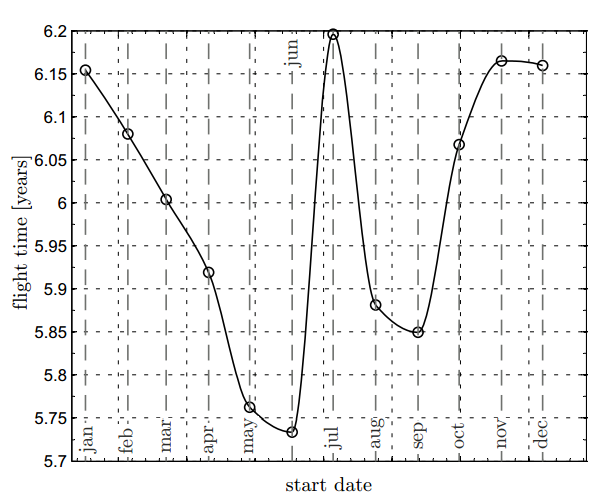New Form of Spacecraft Propulsion Proposed For Uranus Mission
Humankind has sent only handful of spacecraft to the outer Solar System beyond the asteroid belt. There were the Pioneers and Voyagers that left Earth in the 1970s. The Galileo mission headed to Jupiter in 1989 and Cassini-Huygens to Saturn in 1997. Finally, the New Horizons mission left Earth in 2006 and is currently heading towards Pluto and the Kuiper Belt.

One problem with these missions is the sheer time and cost involved. Galileo took 6 years to reach Jupiter and cost about $1.6 billion while Cassini-Huygens took 7 years to get to Saturn and cost almost as much.
Now, a Finnish-led team is proposing a mission to Uranus powered by an exotic new form of propulsion that is currently being tested in Earth orbit. This propulsion is solar-powered and so does not require on board propellant. And it can send a probe to Uranus in about the same time that Galileo took to get to Jupiter which is less than half as far away. But the costs of such a mission are not yet clear.
One problem for probes visiting the outer Solar System is in generating the velocity necessary to get there, against the pull of the Sun’s gravity. The original plan for the Galileo mission, for example, was to use the space shuttle to place the probe and its booster rocket in Earth orbit. The booster was designed to send the probe directly to Jupiter in less than two years.
But in the aftermath of the Challenger disaster, NASA decided that it would not be sensible to place an unlit rocket in the cargo hold of the shuttle. And since no other rocket could lift Galileo and its booster, NASA had to find another way to get there. Hence the slingshot approach.
The proposed Uranus mission takes an entirely different approach based on the concept of an electric sail or E-sail, which was proposed by Finnish engineer Pekka Janhunen in 2006 (who is also the lead for the new Uranus proposal). An E-sail is significantly different from a conventional solar sail, which generates thrust from the pressure of photons hitting the sail.
By contrast, the E-sail relies on charged particles such as protons and alpha particles in the solar wind. The idea is to generate an electric field around the spacecraft which deflects these ionised particles and generates a force that accelerates the craft throughout its journey.
The sail consists of a set of conducting wires that extend radially from the spacecraft like spokes on a wheel. The electric field is generated using solar power. And with 540 Watts, the sail should generate about 0.5 Newtons accelerating the craft by about 1 mm/s^2.
That should produce a velocity of about 20 km/s by the time it reaches Uranus giving a journey time of about 6 years.
The craft itself is designed in three parts. The first is the E-sail module with solar panels and tether reels to extend the wires. The second is the main body of the craft with chemical thrusters for making trajectory adjustments en route and while close to Uranus, as well as communications equipment for contact with Earth.
The final part is an entry module that is released in to the atmosphere of Uranus, where it makes various scientific measurements for transmission back to Earth via the main craft which acts as a relay.
Janhunen and co say this design would also be suitable for journeys to other gas giants with minor modifications.
That’s an ambitious idea, not least because the E-Sail idea has never been tried on a scale anything like this. One small satellite called ESTCube-1 is currently testing the idea and the European Union has an ongoing research project to test it further. Another Finnish satellite will test the principle in more detail this year but more work will surely be needed for a mission of this type.
Nevertheless, the advantages of E-sails over gravitational slingshots are clear. In addition to being quicker, they can also be launched at almost any time with only minor variations in travel time. By contrast, slingshots can only go when the gravitational gods are in alignment.
What Janhunen and co do not discuss is the cost of such a mission, which to be fair is hard to pin down at this stage of a design. The advantage of a Cassini or Galileo type mission is that these craft operate for years around their target planets sending back huge troves of data albeit at massive cost. The disadvantage is that everything is lost if the spacecraft is lost somehow.
By contrast the E-sail mission sends back a few minutes of data from its fiery entry into the atmosphere. That’s surely valuable but would have to be significantly cheaper to justify.
So a good understanding of the relative costs of these kinds of missions will be crucial in determining whether E-Sails have a future in the exploration of the outer Solar System.
Ref: arxiv.org/abs/1312.6554 : Fast E-Sail Uranus Entry Probe Mission
Keep Reading
Most Popular
Large language models can do jaw-dropping things. But nobody knows exactly why.
And that's a problem. Figuring it out is one of the biggest scientific puzzles of our time and a crucial step towards controlling more powerful future models.
The problem with plug-in hybrids? Their drivers.
Plug-in hybrids are often sold as a transition to EVs, but new data from Europe shows we’re still underestimating the emissions they produce.
Google DeepMind’s new generative model makes Super Mario–like games from scratch
Genie learns how to control games by watching hours and hours of video. It could help train next-gen robots too.
How scientists traced a mysterious covid case back to six toilets
When wastewater surveillance turns into a hunt for a single infected individual, the ethics get tricky.
Stay connected
Get the latest updates from
MIT Technology Review
Discover special offers, top stories, upcoming events, and more.